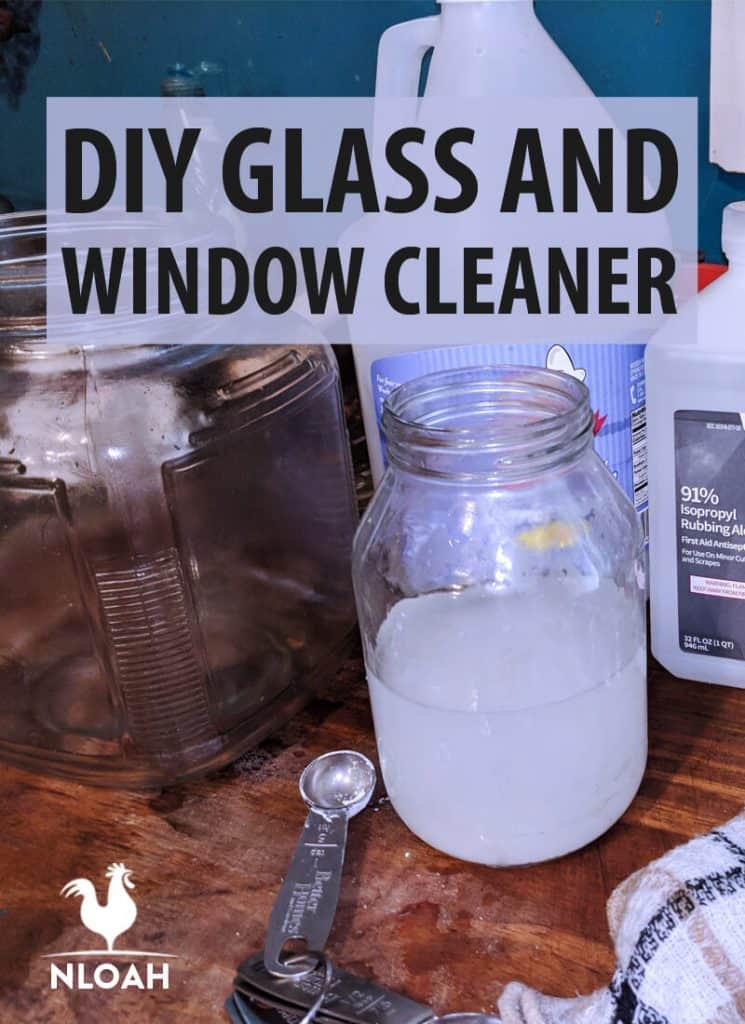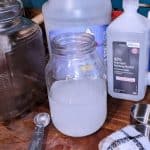Cleaning your glass and windows and being left with a streak free shine does not require the use of costly and possibly harmful, store-bought glass cleaners.
Removing grit and grime from glass, and leaving the surface looking beautiful can be easily accomplished with this DIY natural glass cleaner for mere pennies on the dollar.
Are Glass and Window Cleaners Toxic?
As noted in other DIY all-natural cleaner recipes here at New Life On A Homestead, many commercially manufactured cleaning products could contain potentially harmful synthetic ingredients and chemical compounds.
Thanks to proprietary laws, we will likely never know a full list of ingredients for any cleaning, personal care, or fragrance product we purchase.
Some common possible negative health effects that could be associated with cleaning product ingredients include:
- Respiratory Irritation
- Skin Irritation
- Chemical Burns
- Asthma
- Dermatitis
Because cleaning product manufacturers are not legally mandated to list all of their ingredients on the label, it would be impossible to determine exactly what potential health risks fully exist after chronic exposure.
But, some of the most commonly used active ingredients in window and glass cleaners include:
Phthalates
These chemical compounds are commonly used in window cleaners, fabric softeners, deodorizing cleaning products, and laundry detergents.
Phthalataes might be linked to negative health effects on boys, might prompt a reduced sperm count in men, and could cause children with asthma to experience allergy-like symptoms.
Ammonia
This ingredient is used in window cleaners because it is not only a mild germ killing disinfectant but also because it works as a degreaser. Unfortunately, merely smelling ammonia (especially in an improperly vented space like a bathroom) can cause the throat, skin, lungs, and eyes to become irritated.
Ammonia exposure could cause to the protective mucus membranes in the nose. If ammonia and bleach are accidentally exposed to each other the extremely dangerous chloramine gas can be created.
Kidney or liver damage might be caused by ammonia exposure. Folks with asthma may be more sensitive to exposure to ammonia than other individuals.
Butyl Cellosolve – Glycol Ethers
These chemical compounds are also commonly referred to as: Ethylene glycol monobutyl ether, 2-butoxyethanol, or 2-butoxyethanol acetate or. They are a common ingredient in commercially manufactured all-purpose cleaners as well as glass and window cleaners.
Many to most glycol ethers do not boast any type of scent, so you could be absorbing them into your skin from air vapors and not even realize it.
Glycol ether compounds might be linked to fertility problems in both women and men, kidney damage, liver damage, anemia, autism, and chronic fatigue.
DIY Glass and Window Cleaner Recipe
Ingredients
- 2 cups water
- ¼ cup distilled white vinegar
- ¼ cup rubbing alcohol
- 1 tablespoon cornstarch optional
- 10 drops of your favorite essential oils optional
Instructions
- Pour all of the ingredients into a bottle.
- Place the firm fitting lid on the bottle.
- Shake vigorously to combine the ingredients for about 30 seconds.
Video
Usage and Storage Tips
- Simply give the bottle a shake before each use, then squirt the glass or window area being cleaned. This natural cleaning solution evaporates very quickly.
- Immediately wipe the surface clean, and allow it to dry thoroughly.
- Store in a cool and dry space.
- This DIY natural window and glass cleaner recipe should remain potent for a minimum of four weeks after being created. The cornstarch will settle more over time, and will require vigorous shaking before each use.
Using just rubbing alcohol or distilled white vinegar to clean windows and glass will work well. But, using both of the natural ingredients together, especially when combined with cornstarch and water, will work even better.
When distilled white vinegar and rubbing alcohol are combined you wind up with an excellent all-natural streak free glass and window cleaner. In my opinion, this type of natural cleaner works at least as well as commercially manufactured product- and without all of the potential health risks.
The optional but highly recommended cornstarch is added to this natural glass and window cleaner recipe because it is extremely beneficial when dealing with beveled or decorative glass that is not merely flat and level in design.
The cornstarch helps to break down the water bonds and prevent spotting and streaks in the glass. Even seemingly smooth glass surfaces boast small pitting and can benefit from the addition of the cornstarch.
This distilled white vinegar, rubbing alcohol, cornstarch, and water glass and window cleaner recipe also works well on chrome, window screens, and ceramic surfaces.


Tara lives on a 56 acres farm in the Appalachian Mountains, where she faces homesteading and farming challenges every single day, raising chickens, goats, horses, and tons of vegetables. She’s an expert in all sorts of homesteading skills such as hide tanning, doll making, tree tapping, and many more.

